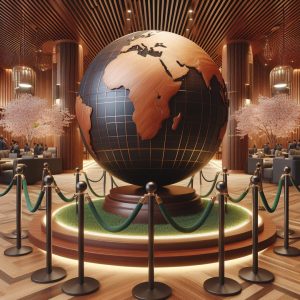 Stanchion Masters® has conducted extensive research on the ever-evolving landscape of hotels, restaurants, and various commercial venues both in the United States and worldwide. Our findings shed light on the prevalent areas where commercial interior designers are passionately transforming spaces through the innovative use of wood and wooden decor. From stylish hotels to trendy restaurants and bustling commercial establishments, the incorporation of wooden elements has become a prominent and sought-after design choice.
Stanchion Masters® has conducted extensive research on the ever-evolving landscape of hotels, restaurants, and various commercial venues both in the United States and worldwide. Our findings shed light on the prevalent areas where commercial interior designers are passionately transforming spaces through the innovative use of wood and wooden decor. From stylish hotels to trendy restaurants and bustling commercial establishments, the incorporation of wooden elements has become a prominent and sought-after design choice.
In the realm of hotels, interior designers are embracing the warm and inviting ambiance that wood effortlessly brings to lobbies, reception areas, and lounges. The rich textures and natural beauty of wooden stanchions and crowd control barriers flawlessly complement the overall aesthetic, creating an atmosphere that exudes sophistication and comfort. These versatile wooden accents seamlessly blend with various design styles, whether it be the sleek modernity of a contemporary hotel or the timeless charm of a rustic lodge.
Restaurants, too, have witnessed a surge in the utilization of wood as a key element in their interior design endeavors. From rustic farm-to-table eateries to chic urban bistros, wooden stanchions and crowd control barriers play a pivotal role in defining spaces and enhancing the overall dining experience. Interior designers carefully select and incorporate different types of wood to create unique atmospheres that align with the restaurant’s concept and ambiance. The eloquent combination of wood, metal, and other complementary materials results in visually striking interiors that leave a lasting impression on patrons.
Commercial venues, ranging from convention centers to shopping malls, are also embracing the allure of wood in their redesign and remodeling efforts. Interior designers recognize the immense potential of wooden stanchions and crowd control barriers to not only efficiently manage crowds but also elevate the overall aesthetic appeal of these spaces. By strategically placing wooden elements throughout these venues, designers create visually appealing pathways that seamlessly guide visitors while adding a touch of warmth and elegance to the overall environment.
Furthermore, the incorporation of wooden stanchions and crowd control barriers extends beyond their functional and aesthetic value. The use of sustainably-sourced wood aligns with the growing demand for eco-friendly design choices, catering to the environmentally-conscious consumer. This fusion of sustainable materials with innovative design concepts showcases the commitment of commercial interior designers to create spaces that are visually stunning, functional, and environmentally responsible.
In conclusion, Stanchion Masters®’ research reveals a notable trend among commercial interior designers in their consistent utilization of wood and wooden decor. From hotels to restaurants and commercial venues, the inclusion of wooden stanchions and crowd control barriers has become an integral part of transformative interior design projects. This enduring and versatile design choice not only enhances the aesthetic appeal of these spaces but also contributes to creating welcoming environments that leave a lasting impression on visitors.
Here are the Top 10 Countries Commercially Decorating With Wood:
1. United States: Popular across styles, from rustic cabins to sleek mid-century modern. Reclaimed wood, exposed beams, and warm wood furniture are common.
 Taking a deeper dive into the USA, the are some of the top locations using wood or faux wood decor:
Taking a deeper dive into the USA, the are some of the top locations using wood or faux wood decor:
-
- Pacific Northwest (Seattle, Portland): Embraces natural materials with exposed beams, reclaimed wood furniture, and warm wood accents.
- Napa Valley, California: Rustic chic and vineyard-inspired themes are popular, featuring reclaimed wood, natural accents, and outdoor spaces.
- Adirondacks, New York: Rustic lodge aesthetic reigns supreme, with exposed beams, log furniture, and natural wood accents.
- Asheville, North Carolina: Mountain modern and rustic styles blend, featuring reclaimed wood, warm wood tones, and natural accents.
- Austin, Texas: Varies widely, with rustic, modern, and industrial styles incorporating wood accents.
- Jackson Hole, Wyoming: Rustic lodge aesthetic dominates, with exposed beams, log furniture, and natural wood accents.
- Charleston, South Carolina: Southern charm meets modern touches, with reclaimed wood, shiplap walls, and warm wood accents.
- Santa Fe, New Mexico: Rustic Southwest style prevails, featuring exposed beams, natural wood furniture, and regional accents.
- Nantucket, Massachusetts: Beachy chic and nautical styles dominate, with light-colored wood furniture, shiplap walls, and natural accents.
- Carmel-by-the-Sea, California: Rustic charm and natural influences combine, featuring exposed beams, reclaimed wood furniture, and natural accents.
2. Japan: Deeply ingrained in design culture, with exposed beams, slatted walls, and warm wood furniture being prevalent.
3. Mexico: Blends rustic and modern, featuring reclaimed wood furniture, decorative accents, and outdoor wooden structures.
4. Scandinavia (Denmark, Sweden, Norway): Minimalist and functional, utilizing light-colored wood for furniture, flooring, and wall paneling.
5. Thailand: Emphasizes local craftsmanship with sustainable teak wood used extensively for furniture, accents, and even outdoor structures.
6. Italy: Classic and elegant, featuring rich woods like walnut and mahogany for furniture and accents.
7. France: Classic with a modern twist, using light-colored wood for furniture and accents, often paired with brass for stanchions.
8. United Kingdom: Reclaimed wood and exposed beams are popular in pubs and restaurants, offering warmth and character.
9. Spain: Varies regionally, with rustic styles in some areas and modern interpretations in others.
10. Germany: Practical and functional, often incorporating wood for furniture, flooring, and outdoor spaces.
COMMON BUSINESSES THAT USE WOOD DECOR
- Coffee Shops: Coffee shops are known for their warm and inviting atmosphere, and wood decor is a great way to achieve that. Exposed brick walls are often paired with wooden furniture, beams, and paneling.
- Pubs: Pubs traditionally feature dark wood paneling, creating a cozy and intimate space. Wooden beams and trusses are also common architectural elements.
- Breweries: Breweries often have a rustic feel, and wood decor helps to create that ambiance. Wooden tables, chairs, and barrels are commonly used, and some breweries even have wooden floors.
- Lodges: This one is a no brainer! Mountain and country lodges, ski resorts all utilize wood decor to blend in with the natural surrounds as well as creating a calming atmosphere
- Visitor Centers: Similar to lodges and resorts, the visitor centers at zoos, botanical gardens and our State and National Parks all utilize wood decor to blend in with the natural surrounds as well as creating a calming atmosphere.
- Restaurants: The type of wood decor used in a restaurant will vary depending on the cuisine. Fine dining establishments might use mahogany or walnut, while casual restaurants might use pine or reclaimed wood. Wooden furniture, paneling, and accents are all popular choices.
- College Campuses: College campuses often have a mix of old and new buildings, and wood decor is a common feature in both. Older buildings might have wooden floors, trim, and furniture, while newer buildings might use wood accents to create a warm and inviting feel.
- Retail Stores: Retail stores use wood decor to create a certain ambiance, depending on the brand image. Upscale stores might use wood paneling and furniture to create a luxurious feel, while more casual stores might use reclaimed wood to create a rustic vibe.
- Hotels: Hotels use wood decor to create a warm and inviting atmosphere for their guests. Wooden furniture, headboards, and trim are all commonly used. Luxury hotels might use more exotic woods, such as mahogany or teak. 1 0. Co-working spaces: Co-working spaces are designed to be both productive and stylish, and wood decor is a great way to achieve that balance. Wooden furniture, walls, and accents can help to create a warm and inviting atmosphere that is also conducive to work.
